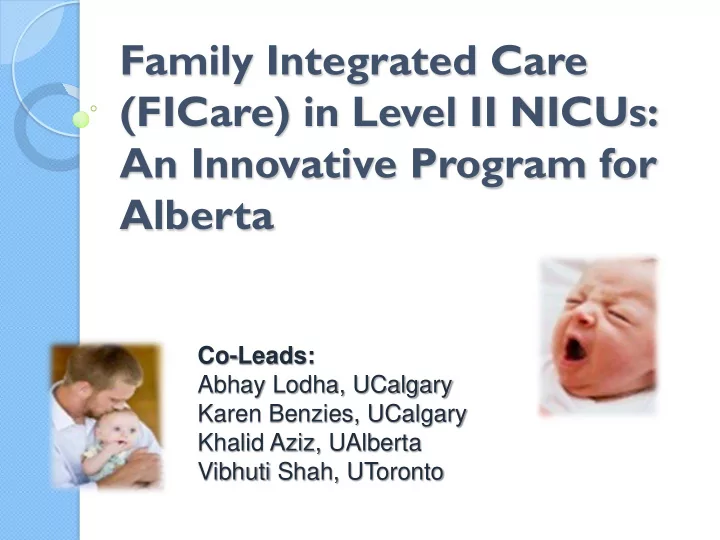

Family Integrated Care (FICare) in Level II NICUs: An Innovative Program for Alberta Co-Leads: Abhay Lodha, UCalgary Karen Benzies, UCalgary Khalid Aziz, UAlberta Vibhuti Shah, UToronto
Acknowledgement Alberta Innovates – Health Solutions, Partnership for Innovation in Health Services Research
Multi-disciplinary Collaborators Albert Akierman – Section Chief, Neonatology, AHS, Calgary Harish Amin – Associate Professor, UCalgary; NICU ACH, Calgary Radha Chari – Associate Professor/Chair, Dept. OB/GYN, RAH, Edmonton Jeff Hoch – Associate Professor, UToronto Wanrudee Isaranuwatchai – Research Associate and Health Economist, SMH, Toronto Jill Larocque – Neonatal Nurse Practitioner, RAH, Edmonton Kelly Mrklas – Knowledge Translation Implementation Scientist, AHS Christopher Naugler – Section Chief Pathologist, Calgary Laboratory Services
Multi-disciplinary Collaborators Luz Palacios-Derflingher – Biostatistician; Adjunct Assistant Professor, UCalgary Ernest Phillipos – Section Chief, Neonatology, AHS, Edmonton Jeanne Scotland – Neonatal Nurse Practitioner, RGH, Calgary Amuchou Soraisham – Associate Professor, UCalgary; NICU FMC, Calgary Katharina Staub – President, Canadian Premature Babies Foundation Tom Stelfox – Associate Professor, UCalgary; SD of Critical Care SCN Esther Suter – Director, Workforce Research & Evaluation, AHS, Calgary Sandra Walker-Kendall – Manager, NICU RGH, Calgary
NICU Medical Directors Khalid Aziz – RAH, Edmonton Harish Amin – SHC, Calgary Essa Al Awad – PLC, Calgary Deborah Clark – RGH, Calgary Santiago Ensenat – GNH, Edmonton Charlotte Foulston – MHR, Medicine Hat John Holland – CRH, Lethbridge Mark Mahood – RDRHC, Red Deer Felix Odaibo – QEII, Grand Prairie Mehaboob Sharif Shaik – ICN MIS, Edmonton
NICU Executive Directors Joanne Cabrera – SHC, Calgary Gail Cameron – GNH and MIS, Edmonton Sharon Dueck – Chinook Regional, Lethbridge Yvonne Gereluk– PLC, Calgary Linda Tessmann-Potvin – Medicine Hat Regional Don Hunt – QEII, Grand Prairie Sandi Sabastian– RDRHC, Red Deer Bridget Smith – RAH and DS, Edmonton Debbie Goulard – RGH, Calgary
NICU Patient Care Managers Irene Anderson – PLC, Calgary Brenda Vandenbeld – Chinook Regional, Lethbridge Becky Eldridge – Medicine Hat Regional Valerie Harrison – GNH, Edmonton Marnie Kumpula – MIS, Edmonton Barb Mehlhorn – RDRHC, Red Deer Karen Pelletier – RAH, Edmonton Diane Sweetman – QEII, Grand Prairie Kimberley Thomas – SHC, Calgary
Research Partners Sandy Davidge – WCHRI Director Selikke Janes-Kelley – Exec. Director APHP, Women’s Health Program; Lois Hole Hospital, Edmonton Brent Scott – ACHRI Executive Director, Calgary Prakesh Shah – Director, Canadian Neonatal Network; Associate Professor at UToronto Suzanne Tough – Interim Director for Maternal, Newborn, Child, and Youth SCN; ACCFCR
Background Alberta has the highest rate of preterm birth in Canada The sickest preterm infants are admitted to a Level III NICU, but the vast majority are admitted to a Level II NICU and still require significant medical intervention Having a preterm infant can be an extremely stressful experience for most parents who are often lacking knowledge or confidence in caring for their babies The highly technological, critical care environment of Level II NICUs often results in parents becoming marginalized during this already stressful time
Background continued Previous models of care that aim to include parents, such as parental presence and family- centered care, have had many challenges (Gooding et al., 2011) A model in Tallinn, Estonia, which actively integrated parents into their infants ’ care, showed promise (Levin, 1994, 1999)
Previous FICare Studies • Matched control pilot study in Level III NICU at Mount Sinai (Bracht et al., 2013; Galarza-Winton et al., 2013; MacDonell et al., 2013; O’Brien et al., 2013; Warre et al., 2014) ◦ Increased rate of weight gain and breastfeeding in FICare group ◦ Decreased parental stress in FICare group • Cluster RCT in Level III NICUs across Canada ◦ To be completed in September 2015 • Mixed methods study in four Level II NICUs in Ontario (Shah et al.) ◦ Qualitative data collection in progress ◦ Next logical step is a cluster RCT in Level II NICUs in Alberta
FICare Level II Alberta Study Primary Research Question: Does FICare for preterm infants with primary admission to Level II NICU reduce hospital length of stay? Method: Cluster RCT in 10 Level II NICUs in Alberta
Theory of Change FACTORS OUTCOMES INFANT FICare ↓ LOS (Primary Outcome) ↓ Nosocomial Infections INFANT e.g. Gestational Age, Apgar, • Empowers parents to Multiple Birth build knowledge, skill PARENT and confidence to care ↑ Confidence ↑ Satisfaction with Care for their preterm infant • Healthcare team and PARENT e.g. Demographics , Mode veteran parents are STAFF of Delivery ↑ Satisfaction educators and coaches ( nursing, medical) COSTS STAFF AND UNIT ↓ Direct Hospital Costs e.g. Training , Years of ↓ Indirect Societal Costs Experience
CRH Lethbridge , Workforce DIMR Operational Grey Nuns Clinicians Research & L eaders T eam Edmonton Evaluation Medicine Hat Hospital Misericordia Hospital FICare Level II Alberta PLC Calgary QE II Grande Prairie Red Deer Hospital RAH Edmonton RGH Calgary SHC Calgary
Milestones 2015 March Ethics Submission May Informational Site Visits September FICare Training & Ethics Approval October Recruitment and Data Collection 2016 Recruitment and Data Collection 2017 December Data Analysis End-of-Grant Knowledge Translation
Group Allocation: Dr. L. Palacios-Derflingher, Biostatistician
Intervention Sites • Grey Nuns Hospital, Edmonton • Misericordia Community Hospital, Edmonton • Red Deer Regional, Red Deer • Queen Elizabeth II Hospital, Grande Prairie • South Health Campus, Calgary Comparison Sites • Chinook Regional Hospital, Lethbridge • Medicine Hat Regional Hospital, Medicine Hat • Peter Lougheed Centre, Calgary • Rockyview General Hospital, Calgary • Royal Alexandra Hospital, Edmonton
Questions?
Recommend
More recommend